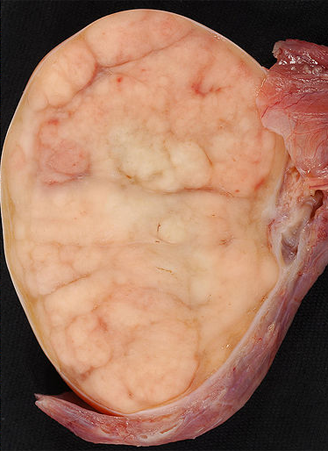Observation Good Option for Stage I Seminoma Testicular Cancer
Results of a combined analysis of SWENOTECA studies showed that surveillance remains a good option for patients with stage I seminoma testicular cancer.
Seminoma of the testis

Results of a combined analysis of SWENOTECA studies (abstract 4508) showed that surveillance remains a good option for patients with stage I seminoma testicular cancer.
Results of the study, presented by Torgrim Tandstad, MD, PhD, of St. Olavs University Hospital, Norway, at the 2014 American Society of Clinical Oncology (ASCO) Annual Meeting, indicated that patients with no risk factors had a low risk of relapse comparable to that seen with one course of adjuvant carboplatin chemotherapy.
“Clinical stage I seminoma is the most frequent presentation of testicular cancer,” Tandstad said. “Current treatment options include surveillance or adjuvant chemotherapy with carboplatin.”
This combined analysis was designed to examine the preferred treatments for patients based on known risk factors for relapse: invasion of rete testis or tumor size greater than 4 cm.
The data presented by Tandstad included 222 patients treated with carboplatin from SWENOTECA V and 391 patients who underwent surveillance and 447 patients who underwent treatment with carboplatin from SWENOTECA VII.
SWENOTECA V was a prospective, population-based study conducted from 2000 to 2007. Initially the study did not include adjuvant carboplatin, but it became a treatment option in 2004. SWENOTECA VII was a prospective, population-based, risk-adapted study conducted from 2007 to 2010. Patients with zero or one risk factor were recommended for surveillance but could choose to undergo one cource of carboplatin, an option almost 50% of patients chose to undergo. Those patients with two risk factors were recommended to undergo treatment with one course of carboplatin but could choose surveillance.
Looking at the entire group of 1,064 patients, there have been only 53 relapses to date, which equates to a relapse-free rate of 93.3% and a cancer-specific survival of 99.7%.
The researchers conducted an analysis to confirm the risk factors used to stratify patients in the study. They confirmed that tumor size of larger than 4 cm (HR = 2.7; 95% CI, 1.5-4.9; P = .001), and invasion of rete testis (HR = 1.8; 95% CI, 1.1-3.2; P = .034) were both associated with increased risk for relapse.
Looking specifically at the 391 patients who underwent surveillance, 22 relapses occurred, equating to a relapse-free rate of 90.5%.
The data were also isolated according to risk factors and according to treatment compared with observation. For patients who chose surveillance, those with zero risk factors had a relapse-free rate of 97.1% compared with 77.2% in those with one or two risk factors (P < .001).
As a whole, patients who underwent treatment with carboplatin had a relapse-free rate of 93.8%. Separated by risk factors, those patients treated with carboplatin with zero risk factors had a relapse-free rate of 97.7% compared with 90.6% for patients with one to two risk factors (P = .003).
Dr. Tandstad pointed out that this rate was a higher relapse rate than that reported by the randomized MRC TE/19/EORTC 30982 trial, but that this study had a higher proportion of patients with risk factors.
An exploratory analysis from MRC TE/19/EORTC 30982 found a trend toward lower relapse-rates in patients receiving 100% dose of carboplatin compared with patients receiving a 90% dose. However, in this study, there were no data to indicate a steep dose response effect.